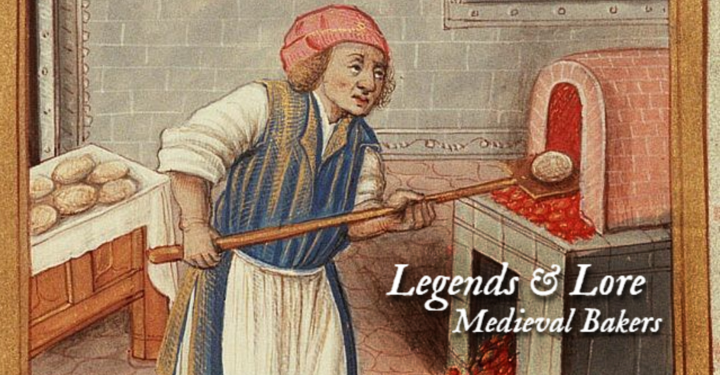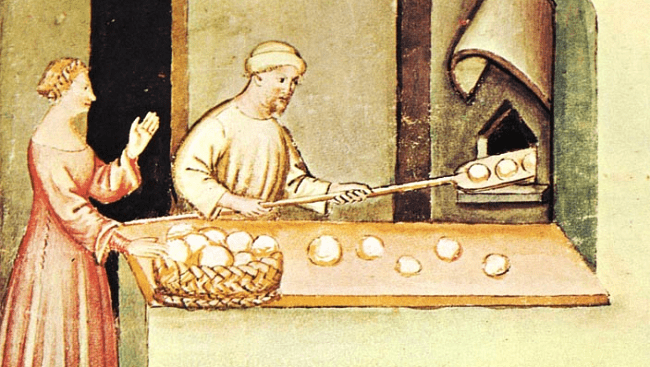
Legends & Lore: Medieval Bakers
It’s safe to say that we all went through some fairly significant phases around this time last year. As the pandemic set in and seemed as if it were here to stay, at-home projects were all the rage on social media. One of the earliest viral sensations that I can recount is bread baking. It seemed like everywhere I looked there was someone else I knew learning the intricacies of focaccia or sharing their perfectly plump loaf of sourdough. Ever since I started working for the Castle it seems like everything reminds me of it – this topic especially given that one of our accommodations is dubbed Baker’s Cottage! Intrigued as ever, I found this to be a perfect subject for our next Legends & Lore: medieval bread baking!
Bread, although eaten by everyone as a staple in the medieval diet, was not as accessible to the extent it is today in both quantity and variety. There were many steps in the bread baking process that, start to finish, meant various parties were involved. The grain itself had to first be grown or purchased. After the grain was procured it needed to be separated from the chaff and then ground. The easiest and most popular way to grind down the grain was to take it to a lord’s mill – which meant paying a fee for that work to be done. Of course, some would try to implement a cheaper option such as the use of a quern-stone, but this task was far more physically demanding and generally not worth all the time and effort. Once the flour was made, beer would provide the yeast and liquid needed to form the dough.
Of course, location plays a big role in what type of bread was available given that some areas were better suited for wheat or other grain crops such as rye, oats, or barley. Wheat grew in nicer, richer soil which typically meant white bread was primarily consumed by the upper class. Manchet is a soft, white, airy loaf of bread that was enjoyed by the elite and provided hardly any nutritional value, especially if we compare it against the oat or bran variety. Then again it goes to show that those who could afford to eat such luxuries didn’t look to bread as their only source of nutrition. Maslin was the bread that most people ate which was (most popularly) mixed with both wheat and rye flours. Rye flour could be used as a standalone as well which produced a darker loaf. These types of breads were most popular among the lower class. All sorts of ingredients could be added into the mix to bulk up the bread from potatoes to peas or apples to turnips.
Given that bread was not a cheap business since many households didn’t have an oven, those that did have the tools could charge for its use or they could make the bread themselves and sell it to their neighbors (more on that later). Communal ovens were also commonplace, but still charged a fee. Due to the size of ovens in medieval times they gave off such an excess of heat that it’s a big reason why more homes didn’t have one. Manors or estates had separate buildings where the oven was kept – which was also helpful to ensure the likelihood of burning the house down was kept as low as possible.
On the topic of ovens, when you think of an oven that functions with fire, what is the first tool you think of? If you said long-handed paddle, you’re correct, similar to the ones you’ve seen used in modern day pizza ovens. However back then, there was no effective way to clean the bottom of the oven which resulted in the bottoms of the bread being blackened. If you were the lord of a manor you need not fret about the burnt bottoms – that portion of the bread was cut off and fed to the lower members of the household while you had the chance to enjoy the “upper crust”. Eventually that exact phrase was used to refer to those in the highest social standing: the upper crust. The more you know!

Bread had many uses in medieval times. For example, a trencher (in Old French tranchier means ‘to cut’) is a flat piece of stale bread that was used as a makeshift plate – perfect for enjoying things like meats, fruits, and other items that did not require a bowl. The trencher could be eaten after a meal, sometimes served with sauce, but most often this temporary flatware was handed out to the poor to eat. This concept later evolved and trenchers were being made with metal or wood and became more of a permanent vessel for serving that wasn’t to be ingested once it’s been used. Modern days examples of a trencher could be compared to something we all know and love: charcuterie boards.
Bakers quickly became part of the guild system. During times of famine, the monarchy could force bakers to make bread below market pricing. Guilds protected bakers and ensured they wouldn’t find themselves without any bread for themselves and their families or in a tough spot financially speaking. Due to the necessity for bakers, the production of supplies needed to create bread was heavily regulated from town to town. There was controlled pricing for bread due to it being such an integral part of everyone’s diets as well as a system of standards for the finished product. Depending on the harvest and how plentiful the grain was affected how much bread someone could get for their money. If the grain supply was costly, then someone could get a much smaller portion of bread than they would had it been bountiful. This system was in place for hundreds of years but occasionally bakers would try to be sneaky and sell bread that wasn’t up to snuff. In London for example some bakers were caught putting items in their bread to make it heavier such as dirt or iron bars!
Being a baker came with its own level of stress. Remaining in good standing with both the baker’s guild and monarchy alongside juggling bread production for the town and having enough for your family at the end of the day was not an easy task. To earn additional income bakers would sometimes let others use their ovens and having a schedule that allowed for that in between the already busy lineup was considered a feat.
But luckily for you, no work is required if you book a stay in Baker’s Cottage at Ravenwood Castle! You can enjoy your stay with us like you’re a lord or lady yourself. Baker’s Cottage is located across the parking lot from the main Castle doors and has a front deck, private bathroom, two bedrooms, full size kitchenette, and electric fireplace. Come kick back and relax in the Baker’s Cottage this summer and leave that crumby winter weather behind!


 Quoth the Raven
Quoth the Raven